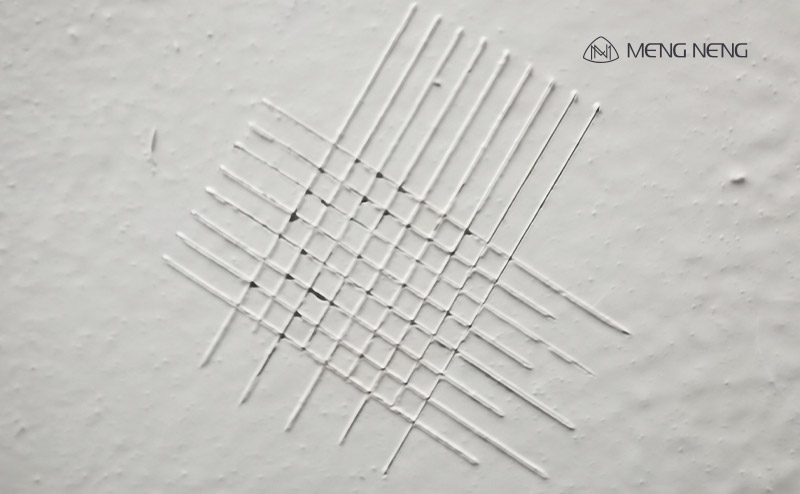Importance and Testing Methods of Coating Adhesion
Coating adhesion refers to the adhesive force between the coating and the substrate surface, which is usually an important indicator for evaluating the performance of coatings. Good adhesion ensures the stability and durability of the coating during use, preventing issues such as peeling, detachment, or bubbling, thereby ensuring the long-term effectiveness of the coating in providing corrosion resistance, decoration, and protection.
Figure (1): Crosshatch Test

I. Importance of Coating Adhesion:
Ensuring coating stability: The stronger the adhesion between the coating and the substrate, the higher the stability of the coating. Strong adhesion ensures that the coating will not peel off or deform during long-term use, thus achieving the intended effect of the coating.
Extending coating lifespan: Good adhesion effectively prevents environmental factors (such as moisture, chemicals, thermal cycles, etc.) from eroding the coating, reducing damage under harsh environmental conditions. In industries like construction, manufacturing, and automotive, coating adhesion directly affects product durability.
Improving corrosion resistance: In the field of anti-corrosion coatings, the adhesion of the coating is the foundation for corrosion protection. Poor adhesion can easily lead to peeling, exposing the substrate to the environment, accelerating the corrosion process. This is especially critical in the corrosion protection of large structures like steel and bridges.
Aesthetic effect: Coatings with strong adhesion maintain a smooth, even surface, enhancing the decorative effect. Conversely, poor adhesion can lead to peeling, cracks, or bubbling, significantly affecting the aesthetics.
II. Factors Affecting Coating Adhesion:
Substrate surface treatment: The cleanliness, roughness, and moisture content of the substrate surface directly impact coating adhesion. For example, if the surface of a steel substrate has oil, rust, or dust, the coating will not adhere well, leading to peeling.
Coating type and formulation: Different types of coatings (such as epoxy resin, polyurethane, acrylic, etc.) have varying compatibility with different substrates. The composition of the coating, such as solid content, resin type, and solvent, also affects adhesion.
Environmental conditions: The environment during the coating application also affects adhesion. Factors like temperature, humidity, and wind speed influence the drying and curing speed of the coating, affecting its adhesion to the substrate. In humid or very cold conditions, the coating may not cure sufficiently, leading to poor adhesion.
Application method: The method of application (such as brushing, spraying, rolling, etc.), uniformity, and coating thickness also affect adhesion. Improper application (such as thin or thick coatings, uneven mixing) can lead to adhesion failures.
Compatibility between coating and substrate: The adhesion is also influenced by the compatibility between the coating and the substrate. For example, certain coatings may adhere well to metals, wood, or plastics, but perform poorly on substrates like glass or aluminum alloys.
III. Coating Adhesion Testing Methods:
Crosshatch Test: The crosshatch test is the most commonly used method for adhesion testing. A specialized knife is used to score a grid pattern on the coating, ensuring the cuts penetrate the coating. Then, tape is applied and quickly removed. If the coating does not peel off noticeably, it indicates good adhesion; if large areas of coating peel off, it indicates poor adhesion.
Tensile Test: The tensile test uses a tension testing device to apply force and measure the minimum force required to peel off the coating. This method quantifies the adhesion and assesses the bonding strength between the coating and substrate.
Impact Test: The impact test applies an impact force to check if the coating is prone to peeling under stress. It is suitable for testing adhesion under impact, vibration, and other external forces.
Peel Test: The peel test detects adhesion by measuring the force required to peel the coating from the substrate. The force directly reflects the adhesion strength between the coating and substrate.
Thermal Peel Test: The thermal peel test involves heating the coating to reduce the adhesion between the coating and the substrate, and then peeling it off to test its adhesion. This method is often used to evaluate adhesion under high-temperature conditions.
Corrosion Resistance Test: The corrosion resistance test, conducted in environments like salt fog and high humidity, checks if the coating's adhesion changes under harsh conditions. The coating's adhesion should remain stable under these conditions.
IV. Methods to Improve Coating Adhesion:
Surface Pretreatment: Proper cleaning and treatment of the substrate surface (such as sanding, sandblasting, degreasing, etc.) removes oil, rust, and dust, increasing the surface roughness and improving adhesion between the coating and substrate.
Choosing the right primer: Using the appropriate primer can improve coating adhesion. Primers are typically used to enhance adhesion and fill in surface imperfections.
Optimizing coating formulation: Improving the coating formulation by selecting suitable resins, additives, and solvents can enhance adhesion. For example, adding adhesives or surfactants helps increase adhesion.
Controlling application environment: Controlling temperature and humidity during application prevents poor curing. A proper environment improves coating curing and enhances adhesion.
Using suitable application methods: Applying the right coating method (such as brushing, spraying, etc.), controlling the coating thickness, and ensuring even application all improve adhesion.
V. Conclusion:
Coating adhesion is a key factor in ensuring the performance of coatings. By applying proper surface treatment, selecting the appropriate coating and primer, controlling the environment and application method, adhesion can be significantly improved, ensuring the stability and durability of coatings. Adhesion testing and optimization are essential steps in every coating application project to ensure coatings perform their protective, decorative, and anti-corrosion roles over the long term.